[Updated February 7, 2019]
Agility. Flyball. Freestyle. Disc. Dock diving. Sledding. Lure coursing. Water rescue. Herding. Skijoring. Retrieving. Tracking. Weight pulling. Schutzhund. And more!
Today’s explosion of canine sports has made sports medicine a veterinary specialty. But, says Carol Helfer, DVM, at Canine Peak Performance Sports Medicine & Physical Rehabilitation Center in Portland, Oregon, competing dogs are prone to injury not because their sports are inherently dangerous but because canine athletes seldom receive the conditioning training that keeps them strong, balanced, and coordinated.
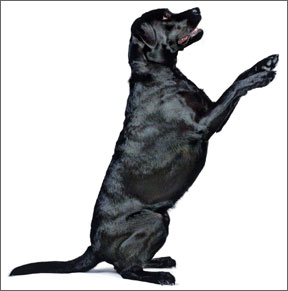
“The whole notion of injury prevention through proper conditioning is one that’s just beginning to gather attention,” explains Dr. Helfer. “And that’s true for the veterinary community as well as dog handlers and trainers. What I love about this work is that a few simple exercises can dramatically change a dog’s quality of life. In athletic dogs, the proof is in their continued good health, enhanced performance, and absence of injuries. Elderly and sedentary dogs benefit, too, and they quickly show increased range of motion and a renewed enthusiasm for activities.”
How Dogs Work
When Dr. Helfer began to explore conditioning exercise, her attention was focused on canine athletes.
“I work a lot with agility dogs,” she says, “and I compete a little in agility myself. Just looking at how dogs use their bodies on the agility equipment and thinking about the kinds of injuries I see in the clinic got me interested in figuring out how to change things so that injuries would be less common. Once you get past some obvious problems, like poor course design or poor handling skills, most of it has to do with the dogs’ ability to quickly and accurately shift their weight.”
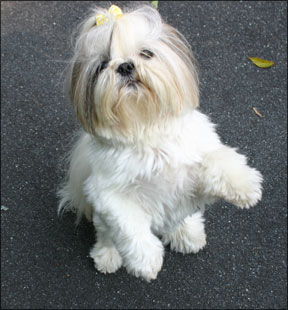
Because not everyone is a world-class handler, she says, people moving with their dogs often end up where they didn’t intend to be, or their commands are late, leaving dogs to twist, run, catch up, or move in a new direction. “In those situations,” she says, “the possibility of injury expands exponentially.”
Dr. Helfer realized that dogs who have good balance and core body strength quickly recover from not-so-great landings and rapid direction changes. Her findings agree with theories developed 80 years ago by fitness guru Joseph Pilates (pronounced Pih-LAH-tees), who focused on what he called “core” muscles: abdominal muscles and muscles around the lower back, pelvis, hips, and buttocks, all of which support the trunk of the body.
In humans, Pilates exercises flatten the stomach, improve posture, alleviate back pain, enhance athletic performance, improve balance and coordination, increase flexibility, improve range of motion, deepen breathing, alleviate stress and physical tension, reduce injuries, and increase body awareness. As Dr. Helfer suggests, there’s no reason why dogs can’t enjoy similar benefits from similar conditioning.
Suggested Conditioning Exercises for Dogs
To help keep her clients’ dogs active and agile, Dr. Helfer designed a series of exercises that she calls “trick training.” Most of the movements are familiar tricks, like rolling over, bowing, or chasing the tail. “What makes them work as core conditioning exercises,” she says, “is their daily application. And when a movement can be done in one direction, such as rolling over or chasing the tail, it’s important to do it in the opposite direction, too.”
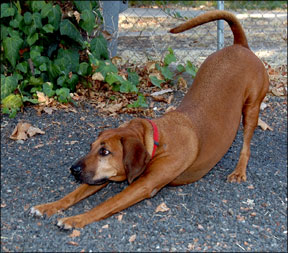
According to Dr. Helfer, most dogs have a preferred side – they are right-handed or left-handed, just like people – so it’s easy to default to the side the dog prefers. “But if you’re serious about core body strengthening, you have to work both sides and in many cases do more on the less-used side to bring things into balance.” No matter what your dog’s sport, says Dr. Helfer, his exercise plan should consist of three basic parts: endurance, strength, and skills.
“Endurance is the bedrock of the well-conditioned dog. To me this means 20 minutes or more of moderate-intensity exercise like trotting or swimming.
“Strength training is high-intensity, short-duration sprinting exercise, like turning on the afterburners for half a minute or so to fetch a ball or bumper, or just running really fast, chasing a Frisbee, or racing to a flyball. If you have a safe place to ride a bike with your dog running along, that works well, too. You can alternate between riding slowly and fast while your dog walks and runs beside you. Many dogs do well with daily sprint work, but you may want to put a day of rest between workouts.”
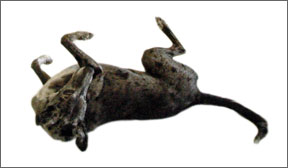
The skills portion of training is obvious. It involves familiarity with the sport and its equipment as well as regular practice.
All three components have to be in place for dogs to excel as athletes. “Too many people, when they’re competing in dog sports, think that going to class once a week and practicing in the backyard three or four times a week for 10 minutes at a time is sufficient conditioning for competition,” says Dr. Helfer. “When you look at what we ask our dogs to do with their bodies, you can see that that’s totally inadequate.”
When practicing or competing in agility or any other sport, take the time to warm your dog up and, after exertion, cool your dog down. “Give your dog a chance to move,” says Dr. Helfer. “All too often in agility, obedience, and other classes, you’ll see dogs and handlers standing around until it’s their turn, then the dog runs or jumps or whatever, and then the dog and handler stop and wait some more. This is a serious mistake when it comes to athletic training. Use that down time to get your dog warmed up, and when your turn is over, don’t just stop, keep moving and gradually slow your dog down. Warm-ups and cool-downs are two of the most neglected parts of training.”
Photo by Dr. Helfer
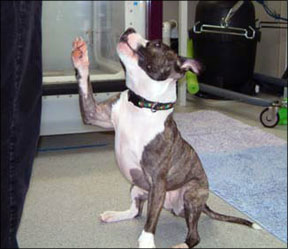
The Right Warm-Up Exercises for Dogs
To determine the right warm-up exercises for canine athletes, think about the work they’ll be doing. “To warm up the body for competition or practice,” says Dr. Helfer, “use the muscles you’ll use in the event. It doesn’t do much good to do hand stands if you’re going to run a hundred-yard dash. It’s difficult with dogs to isolate muscles that specifically, but when the event is weight pulling or sledding, the muscles you want to warm up are very different from the muscles used in agility or freestyle.”
For every patient, Dr. Helfer prepares a written home exercise program with suggestions for appropriate warm-ups prior to practice or competition. Walking, she says, is an excellent all-purpose warm-up that gets the muscles moving. Then consider the sport and whether it requires endurance, strength, or flexibility.
For example, skijoring, sled pulling, and tracking are primarily endurance sports, so dogs need more endurance work than sprint or strength work as part of their foundation conditioning. Weight-pulling is a strength sport and therefore requires more high-intensity/short-duration conditioning. Agility and disc catching require speed and flexibility.
Photo by Dr. Helfer
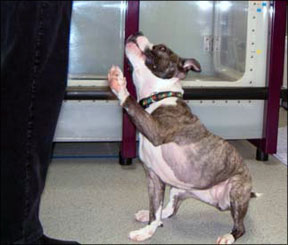
“As far as specific warm-ups for all of the different sports are concerned,” she says, “I think it’s best not to make things too complicated. Get your dog out of her crate in plenty of time to do a decent warm-up before your event. I usually start with a walk, moving into a trot for 5 to 10 minutes. If the event involves jumping, there is often a practice jump set up outside the competition area. Once you’ve done your initial warm-up, taking your dog over the practice jump a few times can begin to warm up those jumping muscles.”
Once the warm-up is out of the way, there is usually a delay before you get into the ring and begin competing. “While I’m standing in line,” she says, “I try to keep my dog moving with spins, begs, high-fives, etc. Doing this also helps you and your dog focus on each other prior to going into the ring.
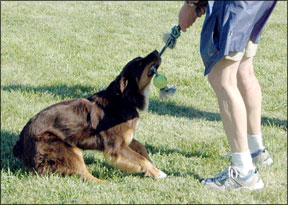
“There is a fine line between a good warm-up and too much. The goal is to get your dog primed to go in and give her best possible performance. This will likely involve some experimentation and observation before you figure out what works best for your dog.”
Daily Conditioning Exercises for Dogs
Dr. Helfer recommends that young, athletic dogs who are in good health do each of the following exercises once or twice per day. Older dogs and dogs who are not used to exercise should begin more gradually, such as two or three exercises every other day, allowing ample time for recovery, then gradually increase the regimen as the dog’s fitness level improves.
“If there is one single thing I wish I could teach all handlers,” she says, “it’s that just because the dog will do an exercise doesn’t mean that he or she should do it. People often get into trouble because they don’t realize that their dogs are overdoing it. One reason they don’t notice is because they get caught up in the sport, paying more attention to the time clock or insisting on one more practice run without focusing on the dog, who may be tired, confused, or stressed. Another is because many dogs keep saying, ‘Let’s do some more!’ The Border Collie is the poster child of this problem, but Labrador Retrievers are just as bad, and really, any high-drive dogs who love what they’re doing cannot be counted on to tell you when they’ve had enough.
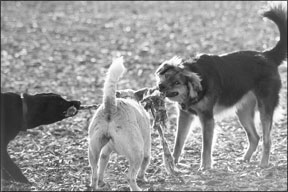
“We’re the ones with the big brains and the opposable thumbs; it’s up to us to figure out when it’s time to slow down, cool down, and rest – and to do that long before our dogs hurt themselves. When in doubt, err on the side of caution.” The following exercises can be done in any order and whenever it’s convenient throughout the day.
“A picture is worth a thousands words,” says Dr. Helfer, “so in addition to studying these instructions and checking the illustrations, I recommend the excellent new DVD by veterinarians Christine Zink and Laurie McCauley, Building the Canine Athlete: Strength, Stretch, Endurance, and Body Awareness Exercises. It demonstrates most of the exercises I use, and for someone who is serious about pursuing a conditioning program for dogs involved in any sport, I think this is an essential DVD.”
Roll Over
Here’s the perennial favorite. If your dog knows how to roll over on both sides, simply have him do one or two roll-overs in each direction. If, like most dogs, he rolls more in one direction than the other, start strengthening the opposite side by having him roll twice or three times from the less-used side for every time he rolls from his habitual side.
Photo by Dr. Carol Helfer
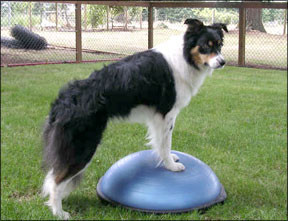
If your dog doesn’t know how to roll over, start with the dog in a down-stay and, holding a treat or toy near his nose, move it to the side of one shoulder, luring the head. After repeating and rewarding that motion, pull the lure up to the spine. When the dog begins to lose his balance, reward and praise him. Eventually, with time and practice, he will roll onto his back and then all the way over.
Scratch Your Back
Some dogs love to lie on their backs, and if you rub their bellies, they’ll wriggle from side to side. Many dogs do this as they roll in grass or in snow. “This is a terrific core strengthening exercise,” says Dr. Helfer. “Do this for several seconds a few times, trying for a longer scratch each time.”
Down Dog and Up Dog (Bow and Stretch)
All dogs bow. The easiest way to teach this trick is to wait for your dog to come out of her crate or stand after sleeping. When she stretches all the way from fully extended front feet to up-in-the-air tail, give a click or praise and reward. In yoga, this is the “down dog” posture.

0)]
Most dogs follow or precede the bow with a second stretch by pulling their bodies forward and dragging the hind feet. In yoga, this is the “up dog” posture.
“I love these positions for their flexibility,” says Dr. Helfer. “There just aren’t many things you can convince a dog to do that will extend the spine like this. Bowing and stretching are easy ways to get that much-needed spine extension.”
Neck Stretch
With your dog standing, use a treat to lure the head up and back as far as it will go, then to the left and to the right, and down to the floor between the legs, pulling the treat back toward the hind legs. Move slowly so the neck muscles really stretch. Pause and repeat, trying for a slightly longer extension and duration.
Spin (Chase Your Tail)
An easy way to teach this trick is to lure your standing dog to the left or right with a treat or toy. Canine freestylers use this maneuver in dance routines, and it’s a fun addition to loose-lead walking. Have your dog spin three or four times in each direction. Alternate between having your dog on your left and on your right while he’s doing the spins. Or simply teach the command and encourage your dog to make as many turns as possible.

1)]
Sit Up and Beg
“This is a great core-conditioning exercise,” says Dr. Helfer, “although I approach it with caution if a dog has any history of back problems, and this is not an exercise for Dachshunds. Dogs who are significantly overweight shouldn’t try it, either, until they slim down and get in shape. Most core-conditioning exercises are very safe and simple, but I suggest that anyone whose dog might have back health issues check with their veterinarian before trying it.
“Other than that,” she says, “this is my favorite exercise for building core body strength. It’s usually very easy for small dogs, but I’ve taught it to large dogs and older dogs, and it’s done wonders for their coordination.
“Start slowly and gradually build up your dog’s duration. Your starting point depends on the dog’s condition; for many dogs, it starts as a simple stretching exercise in which all four feet stay on the floor. Using a cookie or other treat, lure the dog’s head up as far as it will go and hold that position for a few seconds. Just the act of holding the body up, stretching the neck, and reaching up with the head involves tightening and conditioning key muscles.
“There are many variations you can do once the dog is comfortable holding the position for 10 to 20 seconds. One variation is to hold a treat as a lure so that the dog looks up, down, to the left, and to the right while maintaining her balance in the beg position. “If you want to make it even more challenging, put the dog on a slight incline, such as the end of a dog walk or see-saw or outdoors on a hill, first facing down the incline, then facing up, and then to each side on the incline.”
High Five!
Reaching up with one paw exercises shoulders, front legs, and elbows. Do two or three on each side, aiming for a slightly higher extension and slightly longer duration each time. If your dog favors one side, have her raise the opposite paw an extra time or two.
Walk Backward
This isn’t a body strengthening exercise, says Dr. Helfer, but it helps prevent injury by making the dog more aware of where his rear legs are. Simply walk into your dog until he starts moving backward. Working in a narrow area, like a hallway or between two rows of chairs, helps keep the dog moving in a straight line. As your dog becomes proficient, have him walk longer distances backward, then faster, and, where possible, uphill.
Tug of War
“When I play tug with my dogs,” says Dr. Helfer, “I let them control the movement. I think that letting the dog pull a tug toy straight back is preferable to swinging the dog from side to side, which I see a lot of people do. I don’t know for a fact that a swinging motion is harmful, but for core conditioning, I think a straight-back pulling motion works best.
“You can make the game interesting by standing still and resisting while the dog pulls back, then release the pressure slightly and pull the toy back toward you. If the dog wants to go from side to side, he has complete control of the motion, and that’s fine. The other potential problem I see with tug toys is when a dog comes tearing toward you at top speed and grabs the rope toy. If you hold on tight, which many people do, your dog’s neck gets whipped around severely. That always makes me wince.”
Depending on how you hold the tug, your dog’s pulling motions will strengthen his front or back muscles. “Hold the tug close to the floor and he’ll use his front end,” she says, “whereas if you hold it slightly above his head, he’ll use his rear end more. Some dogs haven’t read that rule book, though, and they do the opposite. Just play with your dog and aim for a whole-body workout.”
Crawl
Some people teach their dogs to crawl by combining the signals for “down” and “come.” Others call their dogs under dining room tables, coffee tables, and other furniture or home-made obstacles, lowering their height until the dog moves forward while flat on the floor.
Side Sit-Ups
With your dog lying on her side, place one hand on the dog’s hip and with the other hold a treat near her nose. “You want to lure the dog to lift her head a few inches without pushing up on an elbow,” says Dr. Helfer, “so that the muscles in the neck and trunk do the lifting.” Start with two or three repetitions of gentle movement on each side, and gradually increase the lift as the dog’s muscles grow stronger.
Keep Your Balance
If you have a rocking chair and if your dog is small enough to sit in it, simply rock the chair back and forth. Your dog will automatically shift her weight to correct her balance with every change of motion.
“With a small dog,” says Dr. Helfer, “you can do something similar with an office chair that swivels. Gently turn the chair one way and then another.”
Dogs can also use products sold for human conditioning, such as BOSU “Balance Trainer” balls. A BOSU Balance Trainer looks like a therapy ball that’s been cut in half so that the person (or dog) can balance on the round side, which is usually easy, or the flat side, which is more challenging. “If you gently push your dog from side to side, with your hands on his hips or shoulders,” says Dr.
Helfer, “he’ll have to adjust his balance in response. If the dog is too large to stand on the ball with all four feet, try it with the front feet on, then the back feet.
“I do the same kind of thing with couch cushions. Take cushions off your couch, set them on the floor, and have your dog stand on them while you give a gentle push from one side and then the other. Or do this on an air mattress or any surface that’s slightly unpredictable.”
There are also rubber balance discs, wobble boards, and other balancing equipment made for humans that can be adapted to canine use.
“Not only do you strengthen the dog’s core by challenging his balance,” says Dr. Helfer, “but you improve his responses and quicken his reflexes.”
Your Dog is Never Too Old to Stretch
Core training benefits all dogs, not just those involved in competition. “My favorite success story is Jill, a Husky-Labrador mix who was a typical, creaky 14-year-old big dog. I’d been doing hydrotherapy with her for quite a while to keep her mobile, and then her owner started bringing her to my Old Dog Exercise Class. Jill’s breakthrough came when she learned to sit up and beg. That was pretty impressive!
“I hear people say their dogs are too old to do much, but they’re mistaken. Old age is not a disease. The longer you can keep dogs active, the healthier they’ll be and the longer you’ll enjoy their company. Sometimes you have to step down the intensity of the activity or its duration, but you’ve got to keep them moving.”
Watch Your Dog
Some of your best core conditioning training tips, says Dr. Helfer, can come directly from your dog. Just watch to see what he does naturally and what he most enjoys.
“Sports like canine freestyle have all kinds of excellent core-conditioning moves built into them, but so do the everyday activities of all dogs,” she says. “Whenever you see your dog doing something that will strengthen his core, reward him and encourage him to do it more often. And put together a simple warm-up routine that you can use before your agility run or other event.”
The results, says Dr. Helfer, are well worth the effort. “Not only will daily core conditioning strengthen your dog’s muscles and reduce the risk of injury, it will also strengthen the bond that connects you and you’ll both have fun.”
Watch Your Dog’s Weight
Dr. Helfer estimates that 80 percent of her canine patients are overweight. “I really believe that most people don’t know what a fit dog looks like,” she says. “If you can’t feel her ribs and if she doesn’t have a well-defined waist, she’s like most American dogs: overweight and under-exercised.”
To remedy that situation, cut back on calories and start taking your dog for longer walks, especially up and down hills and on different surfaces, such as grass, bare earth, rocks, sand, etc. If you can combine long walks with short uphill runs and occasional swims, you’ll provide the cross-training that gives your dog a head start on core conditioning.
CORE CONDITIONING FOR DOGS: OVERVIEW
1. Consult your veterinarian before starting your dog on a new exercise program.
2. Start slowly and cautiously, especially if your dog is not used to exercise, is elderly or overweight, or is recovering from illness or accident.
3. Use positive reinforcement to motivate your dog to learn and perform simple fun tricks that strengthen core muscles.
4. Use these tricks as warm-up and cool-down exercises during practice or competition.
CJ Puotinen, a frequent contributor to Whole Dog Journal, is the author of The Encyclopedia of Natural Pet Care and Natural Remedies for Dogs and Cats.






